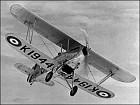
|
Hawker Woodcock 1923 |
The first fighter to be produced by Hawker Engineering
(the successor to Sopwith Aviation), the Woodcock was
designed by Capt B Thomson ... read more ... |

|
Hawker Woodcock II 1924 |
The task of redesigning the Woodcock was undertaken
by W G Carter, who, in fact, retained little of the original
design apart ... read more ... |
The Horsley was produced for the RAF as a bomber and torpedo bomber, entering service in these roles in 1927 ... read more ... |
Hawker Horsley 1925 |
 |

|
Hawker Heron 1925 |
Built as a private venture, the Heron single-seat fighter
was noteworthy in that it was the first of the Hawker
company's fighters ... read more ... |
Representing an attempt to design the smallest and
lightest practical airframe around the most powerful
available engine suitable for fighter installation, the
Hornbill ... read more ... |
Hawker Hornbill 1925 |
 |

|
Hawker Danecock 1925 |
Based on the Woodcock II and designed by Sydney
Camm, the Danecock was developed to meet a requirement
of the Danish Naval ... read more ... |

|
Hawker Hawfinch 1927 |
Designed by Sydney Camm as a potential successor to
the RAF's ageing Siskin fighter, the Hawfinch was built
to Specification F.9/26, being ... read more ... |
The outstanding performance of the Fairey Fox day bomber, undoubtedly came as something of a shock both to Fairey's competitors ... read more ... |
Hawker Hart 1928 |
 |

|
Hawker F.20/27 1928 |
Precursor of the Hornet and Fury, this experimental
single-seat interceptor fighter designed by Sydney
Camm to meet the requirements of Specification
F.20/27 was ... read more ... |
H G Hawker Engineering's first essay into the realm of
the single-seat shipboard fighter, the Hoopoe, was
built as a private venture ... read more ... |
Hawker Hoopoe 1928 |
 |

|
Hawker Tomtit 1928 |
Two-seat training biplane powered by an Armstrong Siddeley Mongoose III radial engine. Small number built for the RAF, for civil ... read more ... |

|
Hawker Osprey 1929 |
The Osprey was a two-seat naval fighter-reconnaissance biplane, developed from the Hart but with additional strengthening for catapult launching, folding ... read more ... |
The Nimrod was basically the FAA version of the Fury single-seat interceptor fighter. In general arrangement and construction it was ... read more ... |
Hawker Nimrod 1930 |
 |

|
Hawker Fury 1931 |
Certainly the fastest and aesthetically one of the most elegant biplanes to enter service with the RAF, the Fury was ... read more ... |
Early experience with the Hart day bomber in squadron service left little doubt that it would prove suitable for adaptation ... read more ... |
Hawker Audax 1932 |
 |

|
Hawker Demon 1933 |
When the Hawker Hart day bomber entered service in January 1930, its performance was so outstanding that it was then, ... read more ... |
Designed to meet the requirements of Specification
F.7/30 calling for a single-seat, four-gun day and night
fighter, the P.V.3 was flown on ... read more ... |
Hawker P.V.3 1934 |
 |

|
Hawker Hardy 1934 |
The Hardy was a two-seat general-purpose biplane developed from the Hart. Production aircraft were built by Gloster Aircraft. The first ... read more ... |
The rapidly changing world of the 1930s forced the British government to take stock of its defences in relation to ... read more ... |
Hawker Hind 1934 |
 |
Few British aircraft have attained the special niche in the history of the RAF which is accorded to the Hawker ... read more ... |
Hawker Hurricane 1935 |
 |

|
Hawker Hartbees 1935 |
The Hartbees was another development of the Hart produced to a South African Air Force requirement for a two-seat general-purpose ... read more ... |
The Hector was developed as a two-seat army cooperation biplane based around a Hind-type fuselage, tail unit and landing gear ... read more ... |
Hawker Hector 1936 |
 |

|
Hawker Henley 1937 |
The Henley was designed as a two-seat-high-performance light bomber. The prototype first flew in March 1937. Despite its promise, its ... read more ... |
When, in 1935, Specification F.9/35 was issued for a
two-seat interceptor fighter to replace the Demon, both
Hawker and Boulton Paul tendered ... read more ... |
Hawker Hotspur 1938 |
 |

|
Hawker Tornado 1939 |
Sydney Camm and his team responded to Specification
F.18/37 which called for a single-seat interceptor, with
two tenders. One was referred to ... read more ... |
Air Ministry Specification F.18/37 was concerned with the design and development of two advanced interceptor fighters: one with a Rolls-Royce ... read more ... |
Hawker Typhoon 1940 |
 |

|
Hawker Tempest 1942 |
The performance of the Typhoon was such that speeds of around 805km/h could be attained in a dive. It was, ... read more ... |

|
Hawker Sea Hawk 1947 |
The Sea Hawk single-seat naval fighter was designed and initially produced by Hawker Air-craft Ltd. Development and series production of ... read more ... |
Rolls-Royce Nene-powered research aircraft built to investigate the controllability and stability of sweptback wings at low speeds. First flown on ... read more ... |
Hawker P.1052 1948 |
 |
Developed as a result of Australian interest in an operational
fighter version of the P.1052 swept-wing research
aircraft, the P.1081 was a ... read more ... |
Hawker P.1081 1950 |
 |
| 
